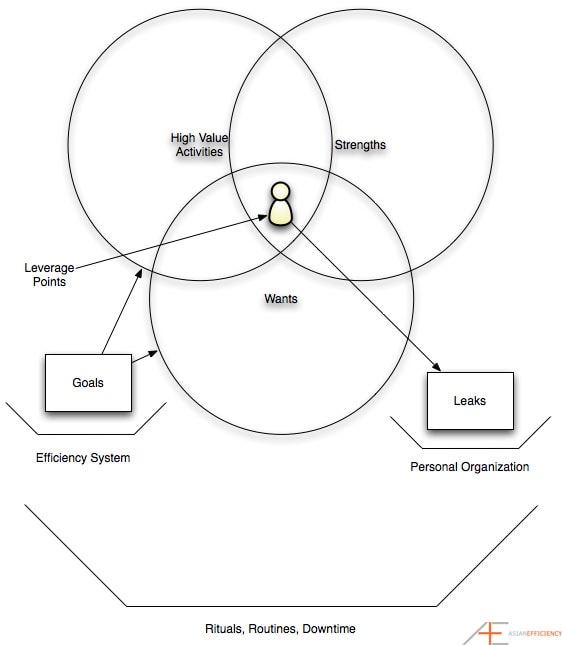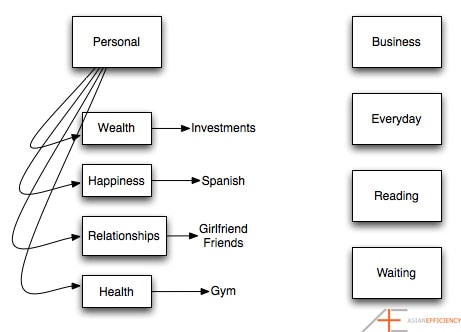
Welcome to the first of (hopefully many) case studies that we’ll be presenting over the upcoming weeks.
While we believe in writing and publishing really great content, we also recognize the need to occasionally take a step back, and show everyone how it’s all put together. Everything that we present at Asian Efficiency is a model – a model for being more productive and more efficient, and for being a better manager of your time and life. But it is still a model that needs to be adapted to your particular circumstances. This is where case studies come in.
Over the next couple of months we’ll be publishing case studies based on consulting work that we’ve done over the past year. (As a side note, we don’t usually take on clients unless it’s a personal favor to someone we know, or someone has reached out through our network and really needs help!)
The thing to keep in mind about all these case studies is that they are all real. Some details have been modified to protect the less-than-efficient, but the core of each individual’s or company’s problems remains the same. The format for these case studies is fairly similar to how we completed the initial consulting work: we looked at each person’s needs and wants in relation to their various areas of life, and made recommendations and an action plan for implementation of more productive processes.
Meet Daniel
Daniel is a successful business owner from Houston in his 30s. He runs a successful brick-and-mortar business, in which he deals with vendors, retailers and consumers on a daily basis. When we first met Daniel, he was haphazardly dividing his time between managing his business, juggling an increasingly-busy social life, and trying to figure out how to drop a number of bad time management habits.
Here are some of the things that he wanted:
- A way to cut down on commute time between his residence and his workplace.
- To free up more time for socializing with friends.
- More time to work on keeping healthy.
- To learn Spanish.
- To get his personal life in order.
We identified some time-wasters and bad habits:
- Multitasking.
- Working last-minute on everything.
- Not knowing what his next action was in any given context.
- Sleeping in, usually as a result of heavy partying.
- Hours spent aimlessly surfing the Internet.
- Too much time spent watching TV.
We also mapped parts of his organizational system:
- Scheduling based on what work dictates.
- A paper to-do list.
- iPhone and a shared calendar for work appointments.
- Journal for reviewing events.
- About to transition to Mac.
- No personal rituals or scheduling.
Daniel 2.0
Based on what we elicited about Daniel’s organizational strengths, weaknesses and what he was after, we put together this:

(In case you are wondering, the little yellow man in the middle is Daniel.)
Let’s take a look at each of the components.
Leverage Points
Leverage points are the intersection of high value activities, natural strengths, and wants. They are the things that you do to push yourself toward your goals, yet also make you happy while doing so. There are two components to leverage: the first is making sure you are doing things where you have optimal leverage, the second is the removal of leaks that would otherwise cause a loss of momentum and progress.
For Daniel, his leverage points coincided with his wants. He was already pretty happy with how his business was operating.
The wants:
- To learn Spanish.
- To spend more time at the gym.
- To free up more time for socializing with friends.
- Switch to Mac.
For learning Spanish, we recommended that he look into Michel Thomas’ language programs. They are described by users as “Pimsleur on crack”, and our own experience with them matches that description quite well. We recommended that Daniel take a 2 week period of intense study with the recordings, and then supplement this on an ongoing basis by finding native speakers to converse with (language exchange programs with international students being a good place to start).
For working out, we helped Daniel identify how many hours he would spend at the gym, and to set aside the same time slot every week to go to the gym (building a habit). Two other environmental support structures we suggested were:
- A training buddy or personal trainer, to help keep Daniel accountable.
- A reward system, whereby attending all scheduled gym sessions would be rewarded with a night out with friends.
To “create” more time to socialize, we suggested that Daniel set aside one night as a “chill” night where there were no outcomes other than to go out with friends and have a good time. To avoid a nasty hangover the following morning, we also provided a simple system:
- Drink water and alcohol in a 1:1 ratio – for each drink taken, a glass of water must also be consumed.
- An alcohol consumption limit of 3 drinks. If necessary, Daniel was to give a friend $100 – only to be returned if fewer than 3 drinks were consumed.
Daniel was already planning to switch to Mac when we first met him.
Handling Leaks
It is one thing to improve efficiency, and it is another to recognize deficiencies in the way we live our lives and to address them. While we are fans of making the most of natural strengths, we also know that it’s important to address weaknesses as best we can, in order to stop them from interfering with the pursuit of our goals.
In Daniel’s case, we had to address:
- An abnormal sleeping schedule.
- Facebook/email/online distractions.
- Multitasking.
When we spoke with Daniel he indicated that he preferred staying up late. Given that we live in a time when shift work, international business and instant communication is prevalent, we don’t see this as a problem – provided you can offset any potential issues. We suggested bright artificial lighting for staying up late, and earplugs and an eye-mask for sleeping during daylight hours. We also recommended:
- He wake up at the same time every day, regardless.
- He set a minimum amount of time he would sleep every day.
- If he woke up before the time set in 1., to just stay awake anyway.
For Facebook and email, we recommended that Daniel check his email and messages twice a day – once in the morning, and once in the evening. And never in-between.
For online distractions, we recommended the Pomodoro Technique and Leechblock as environmental supports to supplement self-discipline.
Daniel also had a habit of leaving the television on in his office while working. The easy solution: move the TV to another room.
Rituals, Routines and Downtime
You’ll notice that the base of the diagram above consists of rituals, routines and downtime. This is because these three things are directly correlated to our physical energy, which is the foundation upon which everything else rests. Without physical capability and energy, we cannot be efficient.
In Daniel’s case (as with a lot of business owners) his personal and business life had a tendency to blur together. This created a stressful mix of meetings, calls, work, socializing and everything else in-between. We recommended that he step back, and reassess the double-edged sword that arises from running a company. The benefit of being the boss is that Daniel was able to implement the idea of being able to work on whatever he felt like at any given time (after taking into account responsibilities towards his company). We suggested that he limit business-related tasks to the office (and to stay late if necessary) and to keep personal tasks confined to home.
One of Daniel’s main issues was the commute time between his home and office. The solutions we had were to:
- Move closer to the office.
- Maximize time spent commuting using audiobooks.
- Put travel times into schedules, as-if they were appointments with clients.
Daniel also had an issues balancing his downtime: emotionally he felt that he needed more of it, but logically it seemed that he had too much already. We found a comprise: set aside certain nights for downtime and cutting loose, and treat the rest of the time as productivity and goal-focused time. As an example, rather than taking all of Sunday off, Sunday morning was to be set aside to clear actionable tasks.
Two other components that we gave Daniel were a morning ritual, to be completed as a first-thing upon waking, and an evening ritual, to be completed before going to sleep.
Here’s what we recommended:
Daniel’s Morning Ritual
- Wake up.
- Drink half liter of water.
- Use bathroom (shower, shave).
- Review goals for day. Review from your journal what you will accomplish today. Transfer items due today to paper.*
- Spend 5 minutes visualizing yourself successfully completing your goals.
- Yoga routine (can defer until later in the day).
- Check email, Facebook, phone. Reply, clear and sort as necessary. Synchronize Things.
- Eat breakfast.
- Get dressed.
- Gym (can defer until later in the day).
- Daily activities. Begin with the most important first if there are no morning appointments.
Daniel’s Evening Ritual
- 30 minutes of visualization exercises.
- Transfer any additional notes from paper into your Things inbox, or set them as tasks in Things.*
- Write your journal entry outlining your day. Review what tasks you’ve completed during the day, and see how it compares to your entry from the morning. Set your tasks and review goals for the next day.
- Prepare your workspace for the next day. This should take no longer than 10 minutes.
- Watch television. 1 episode, or 45 minutes. Nothing that gets the heart racing too much.
- Sleep
* You’ll see why in the section on task management below.
Efficiency System
Daniel already had something of an organizational system in place (at least at work). We made some additional suggestions:
- Use iCal on the Mac, together with the Calendar app on his iPhone. Obtain a MobileMe subscription to keep the two in synchronization.
- Use Address Book on the Mac and Contacts on his iPhone. MobileMe for syncing.
- Use Things for simple task management. This handled the issues of not knowing what to do next, and of working last-minute on tasks. Daniel indicated that he preferred to carry his day-to-day tasks on a small piece of paper, which is reflected in the steps in his morning and evening rituals where he transfers daily tasks to and from a piece of paper and Things.
- We suggested that Daniel try taking notes on his iPhone using Things or Notes. He still likes that piece of paper though.
- We also provided Daniel with a simple breakdown of what his task management system would look like:

“Everyday” describes one-off single actions, such as grocery shopping, buying gifts or running errands. “Reading” is for future and current books. “Waiting” is for storing reminders where someone has to get back to Daniel about something.
- For email, we recommended that Daniel follow these guidelines here.
Personal Organization and Getting to Clear
One of the principal problems with knowledge nowadays, is that it is taught as a corrective layer on top of prior knowledge – which are usually based on assumptions and experiences that are fallacies. The notion of Getting to Clear describes the creation of a clean slate upon which future foundations can be built.
To help Daniel “get to clear”, we recommended some environmental changes:
- Spending a weekend clearing personal space (at home). We recommended that he devise a simple sorting system, with the litmus test of being able to find anything he needed within a couple of minutes.
- Daniel had his belongings and documents spread across multiple locations (2 residences and 2 office locations). We told him that it was OK to have some redundancy in order to deal with having to move between the four locations.
- We suggested Daniel outsource his cleaning to a maid on a weekly or fortnightly basis.
In Closing
As you can see, a lot of the recommendations that we made for Daniel were based off the theory and application of the models and systems that we have presented on Asian Efficiency – they have simply been modified to better suit his needs.
Just because we (or any other productivity experts for that matter) suggest that XYZ program is the best, it doesn’t mean that it’s the best for you. Sometimes, a simple piece of paper works just as well.
(Image courtesy of fetish art identification under a Creative Commons Attribution 2.0 generic license.)
